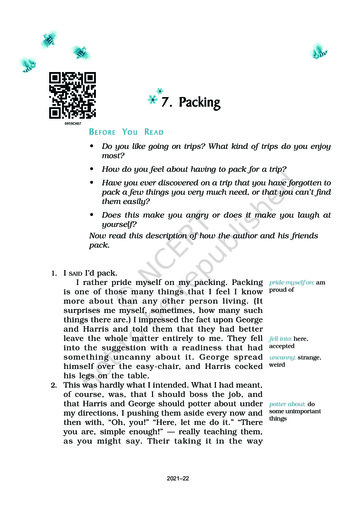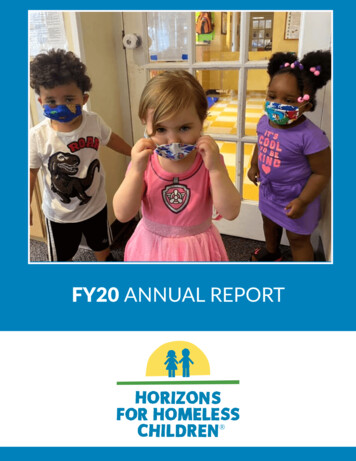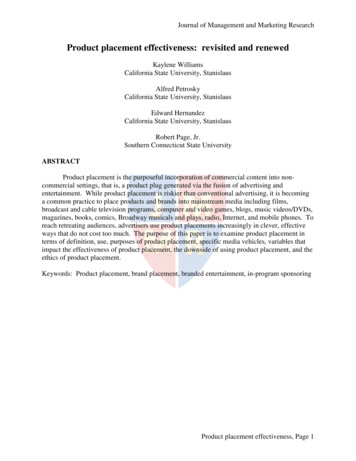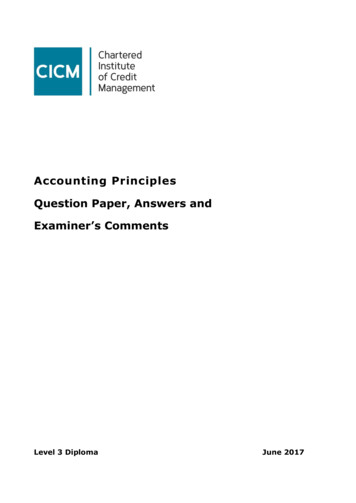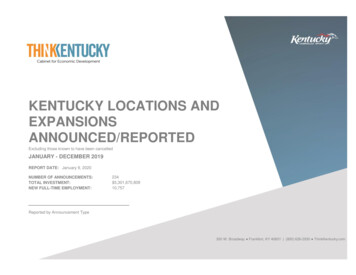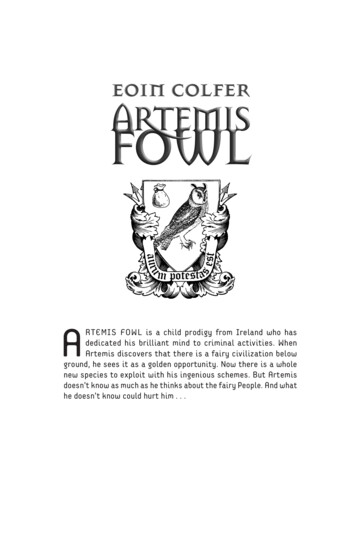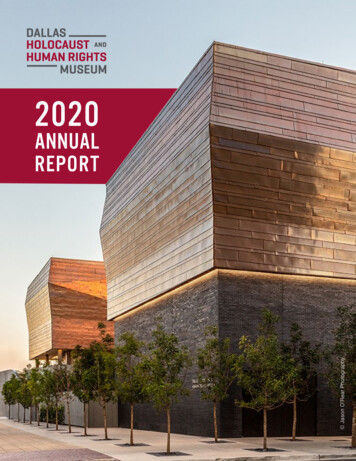
Transcription
urnal of MolJoedtic M icineneular and GeecISSN: 1747-0862Journal of Molecular and GeneticMedicineResearchArticleResearch ArticleKoriem et al., J Mol Genet Med 2013, S1DOI: perglycemic, Antihyperlipidemic and Antiapoptotic Activities ofMicromelum minutum Seeds in Diabetic RatsKhaled MM Koriem1,2*, Muhammad E Aminuddin3, Azham S Kader3 and Noruddin R Sheikh4Advanced Medical and Dental Institute (AMDI), Universiti Sains Malaysia (USM), MalaysiaMedical Physiology Department, National Research Centre, Dokki, Giza, EgyptFaculty of Medicine and Health Sciences, Universiti Putra Malaysia, Malaysia4Department of Biochemistry, Faculty of Biotechnology and Biomolecular Sciences, Universiti Putra Malaysia, Malaysia123AbstractDiabetes mellitus is one of the most common chronic diseases in the whole world. It is a complex, multi-factorialdisease which affects the quality, quantity, and style of an individual’s life. The Micromelum minutum (Family Rutaceae) is a small shrub growing widely in Southeast Asia and the Pacific Islands. In the present study the evaluationof the anti-hyperglycemic, anti-hyperlipidemic and anti-apoptotic activities of Micromelum minutum seeds ethanolicextract in diabetic rats was done. After 30 days of administration the dose (100 mg/kg body weight (bwt) of ethanolicextract of the Micromelum minutum seeds and 25 mg/kg bwt Microminutinin coumarin there was a significant decrease in serum glucose levels; while following two months of administration of the same doses of the seeds extractand coumarin induced a significant decrease in the cholesterol, triglycerides and low density lipoprotein (LDL) levelsand increase in the high density lipoprotein (HDL) level. The treatment with Micromelum minutum seeds extract andits coumarin ingredient to diabetic rats increased p53 expression while decreased bcl-2 expression. Histopathological investigation revealed that Micromelum minutum seeds ethanolic extract (100 mg/kg) and Microminutinin coumarin (25 mg/kg bwt) treatment also increased the number of pancreas β-cells as compared to that of diabetic animals. In conclusion, Micromelum minutum seeds ethanolic extract had anti-hyperglycemic, anti-hyperlipidemic andanti-apoptotic activities and all these activities are related to Microminutinin coumarin ingredient of the plant seeds.Keywords: Hyperglycemia; Hyperlipidemia; Apoptosis; Micromelummade by WHO on diabetes mellitus, exploration on hyperglycemicagents from medicinal plants has become more significant [7].IntroductionThe Micromelum minutum (Family Rutaceae) is a shrub thatreaches up to 3 m in height, growing widely in Southeast Asia andthe Pacific Islands. Its synonym is Micromelum pubescens Blume [8]and is known in Malaysia as chemomar, cherek or kematu. The leavesare used traditionally as a febrifuge, the stems as a carminative, andthe flowers and fruits as an expectorant and a purgative, respectively[9]. The genus Micromelum species are known to contain 6- and8-prenylated coumarins [10-12]. Micromelum minutum seeds waschosen for current study because the seeds are rich source of coumarins.Previous investigation of the leaves of the plant led to the isolation ofbioactive coumarin derivatives such as microminutin [13], flindersine,7,8-dioxygenated coumarins, and triterpenes [13-15], as well as apyranoquinoline alkaloid [13]. Lekphrom et al. [16] isolated a new7-oxygenated coumarin, 7-demethylmurralonginol isovalerate, andmurralonginol, together with seven known coumarins (7-oxygenatedcoumarins, murralonginol isovalerate, murralongin, micromelin,scopoletin, microminutin, murrangatin, and minumicrolin, from thefruits of Micromelum minutum. The methanolic extract of Micromelumminutum; Microminutinin; RatsDiabetes mellitus is one of the most common chronic diseases in thewhole world. It is a complex, multi-factorial disease which affects thequality, quantity, and style of an individual’s life [1]. Diabetes mellitusis a chronic metabolic disorder, mainly characterized by disruption incarbohydrates, protein, and fat metabolism caused by the complete orrelative insufficiency of insulin action [2]. When the amount of bloodglucose in the blood increases, for example, after a meal, it triggers therelease of the hormone insulin from the pancreas. Insulin stimulatesmuscle and fat cells to remove glucose from the blood and stimulatesthe liver to convert glucose to glycogen, causing the blood sugar levelto decrease to the normal level and consequently stimulate pancreasto secret glucagon hormone to increase blood glucose level whereglucagon causes the liver to convert stored glycogen into glucose andhigh amount of glucose is circulating in the blood (hyperglycemia). Tokeep the normal level of glucose in blood, the kidney removes the extrasugar from the blood and excretes it in the urine. Hyperglycemia can behanded initially with oral synthetic agent and insulin therapy. But thesesynthetic agents produce some serious side effects and are relativelyexpensive for developing countries [3,4].The research for a new and natural source to be used in thetreatment of diabetes was increased in the last decade. The medicinalplants provide a new, avaliable and cheap source for developing newdrugs nowadays. Natural products account for more than 40% of allpharmaceuticals on the market today, where from 1941 to 2002, over50% of all the drugs, or new drug entities, available for cancer treatmentwere derived from natural resources [5]. The dependence of large ruralpopulation on medicinal plants for treatment of diabetes is because ofits availability and affordability [6]. Additionally, after the approbationJ Mol Genet Med*Corresponding author: Khaled MM Koriem, Integrative Medicine Cluster,Advanced Medical and Dental Institute (AMDI), Universiti Sains Malaysia (USM),Malaysia, Tel: 604-5622413; Fax: 604-5622349; E-mail: kkoriem@yahoo.comReceived October 0267, 2013; Accepted December 10, 2013; PublishedDecember 16, 2013Citation: Koriem KMM, Aminuddin ME, Kader AS, Sheikh NR (2013)Antihyperglycemic, Antihyperlipidemic and Antiapoptotic Activities of Micromelumminutum Seeds in Diabetic Rats. J Mol Genet Med S1: 004. doi: 10.4172/1747-0862.S1-004Copyright: 2013 Koriem KMM, et al. This is an open-access article distributedunder the terms of the Creative Commons Attribution License, which permitsunrestricted use, distribution, and reproduction in any medium, provided theoriginal author and source are creditedMolecular & Cellular Aspects in Obesity and DiabetesISSN: 1747-0862 JMGM, an open access journal
Citation: Koriem KMM, Aminuddin ME, Kader AS, Sheikh NR (2013) Antihyperglycemic, Antihyperlipidemic and Antiapoptotic Activities of MicromelumMinutum Seeds in Diabetic Rats. J Mol Genet Med S1: 004. doi: 10.4172/1747-0862.S1-004Page 2 of 8minutum exhibit the highest antimutagenic activity in Mutagens,Trp-P-1 among 118 samples (108 species) of edible thailand plants wasexamined by the Ames Test [17]. Micromelum minutum leaves showedcytotoxic activity against leishmania major and cancer cells (lungadenocarcinoma and leukaemia) [18].This study was conducted to investigate the anti-hyperglycemic,anti-hyperlipidemic and anti-apoptotic activities of Micromelumminutum seeds ethanolic extract in diabetic rats.Materials and MethodsAnimals: Adult male diabetic albino rats of Sprague Dawleystrain weighing 200-220 g were obtained from animal house colonyof Universiti Sains Malaysia hospital (HUSM), Kelantan, Malaysia.They were kept under the hygienic conditions and well balanced dietand water. The experiments were carried out according to the Nationalregulations on animal welfare and Institutional Animal EthicalCommittee (IAEC).Drugs: a) Glibenclamide(Glibamide ) was purchased from pfizerPharmaceutical Company, Malaysia; as a standard hypoglycemic drug.MaterialsPlant material: Micromelum minutum seeds were provided fromHorticulture Department, Ministry of Agriculture, Kuala Lumpur inMay 2011. The plant was botanically identified authenticated by Prof.Zhari at the School of Pharmacy, Universiti Sains Malaysia, Malaysia.Voucher specimen of each plant was deposited at the herbarium ofthe School of Pharmacy. The seeds were crushed, pulverized and thenweighed and prepared for extraction.Preparation of the ethanolic extract: Micromelum minutumseeds (1.5 kg) were air-dried in an oven at 40 C for 4 days and then thedry plant was cut and pulverized. Dried Micromelum minutum seeds(500 g) were placed in 1000 ml of distilled boiling water and kept atroom temperature for 15 min. The dried powdered plant material wasmacerated for 7 days using 70% ethanol as a solvent. The solvent wasthen eliminated by a rotary vacuum evaporator under reduced pressureand the subsequent extract lyophilized, representing a yield of 15% ofthe dry material extracted. The extract was evaporated to dryness togive dried ethanolic extract (150 g) according to the method of Chopraet al. [19]. The extraction process was taken one month from collectionof the plant seeds until final ethanolic extract was obtained.Ethanolic extract purity, quality and stability methods: Puritytests (Microbiological, Pesticide residues, Heavy metals, Radioactiveresidues, Chemical, Foreign organic matter and Sulfated ash)were performed in accordance with Malaysian accepted protocolrequirements and accredited to ISO/IEC 17025 consult the WHOguidelines on stability and quality controls methods for medicinalplants [20,21]. The plant extract was stored in a tightly cooling (-4 C)sealed container away from heat and light that prevent any loss ofextract solvent and entry of water; where plant extract dissolved in 1mldistilled water and given orally to individual rat.Determination of lethal dose fifty (LD50) of Micromelum minutumextract: Forty adult albino rats were used in this study and divided into5 equal groups each of 8 rats. The LD50 of the extract was determined inmg/kg body weight [22], where LD50 DM-ΣZ.d/m, DM the highestdose used, Z the number of dead rats of two successive doses dividedby two, d difference between two successive doses, m the number ofrats in each group. Administrations with oral 10% of the LD50 of theextract were found to be safe [23].Thin layer chromatography (TLC) for coumarins isolation: TLCwas used to resolve and isolate the coumarins constituents from theplant extract. Dried seeds of the plant were extracted with acetone atroom temperature. The ethanol extract (2.36 g) was subjected to silicagel column chromatography eluting with hexane and hexane–acetone(7:3, 3:2, 1:1, 1:4), successively, to give 6 fractions. Each fraction wasfurther subjected to silica-gel column chromatography and preparativeTLC with appropriate combinations of hexane, CH2Cl2, iso-Pr2O,J Mol Genet Medbenzene, CHCl3, EtOAc, acetone, and MeOH as developing solvents togive another six coumarins as described in the results below.b) Atorvastatin (Atortatin ) was obtained from PenangPharmaceutical Company, Malaysia; as a standard hypolipidemic drug.c) Kits reagents obtained from Biomerieux Company throughlocal supplier for measuring serum glucose, triglycerides and totalcholesterol fractions. Doses of drugs used were calculated according toPaget and Barnes [24] administered orally by gastric tube. The extractis also administered orally by a gastric tube.MethodsInduction of diabetes: Hyperglycemia was induced by injectingstreptozotocin (STZ) at a dose of 150 mg/kg intraperitoneall (ip) andthe animals were kept under observation. After 48 hrs, the animals weretested for blood glucose using enzymatic colorimetrical method [25].Twelve days after the STZ injection, rats with fasting blood glucoselevels greater than 200 mg/dl were considered diabetic.Determination of anti-hyperglycemic and anti-hyperlipidemicactivities: Five groups each of 8 diabetic rats were used for bothanti-hyperglycemic and anti-hyperlipidemic activities. In antihyperglycemic group, the first group was kept as negative controladministered saline orally. The second group is diabetic rats. The 3rdgroup; diabetic rats treated orally with Glibenclamide (2.5 mg/kg)was used as reference positive control drug suspended in saline [26].The 4th group; diabetic rats treated daily with oral dose of 100 mg/kgbwt of the ethanolic extract of Micromelum minutum seeds; while the5th group; diabetic rats received daily an oral dose of 25 mg/kg bwt ofMicrominutinin coumarin for 15 days and 30 days, respectively. Atzero time, 15 & 30 days after administration of negative and positivecontrols as well the extract and coumarin, blood samples were collectedfrom the retro-orbital plexus through the canthus of the anesthetizedrats after an overnight fasting and serum was isolated by centrifugationand total blood glucose was determined.In anti-hyperlipidemic group the animals were divided also into5 groups; first group was kept as negative control administered salineorally. The 2nd group was diabetic group, the 3rd group treated orallywith standard hypolipidemic drug atorvastatin (positive control) ata dose of 1mg/kg twice a week. The 4th and 5th groups were treateddaily with oral doses of 100 and 25 mg/kg bwt of ethanolic extractof Micromelum minutum seeds and Microminutinin coumarin for 1month and 2 months, respectively. At zero time, 1 month and 2 monthsafter administration of negative and positive controls as well extractand coumarin, blood samples were collected for total serum cholesterol,triglycerides, HDL cholesterol and LDL cholesterol determination.Determination of anti-apoptotic activityPrinciple: At the end of experimental study; the animals weresacrificed by mild ether anesthesia and the pancreas tissues wereMolecular& Cellular Aspects in Obesity and DiabetesISSN: 1747-0862 JMGM, an open access journal
Citation: Koriem KMM, Aminuddin ME, Kader AS, Sheikh NR (2013) Antihyperglycemic, Antihyperlipidemic and Antiapoptotic Activities of MicromelumMinutum Seeds in Diabetic Rats. J Mol Genet Med S1: 004. doi: 10.4172/1747-0862.S1-004Page 3 of 8collected for Immunohistochemical (IHC) staining techniques allowfor the visualization of antigens via sequential application of a specificantibody to the antigen (primary antibody), a secondary antibody tothe primary antibody and an enzyme complex with a chromogenicsubstrate with interposed washing steps. The enzymatic activation ofthe chromogen results in a visible reaction product at the antigen site.The specimen may then be counterstained and overslipped. Results areinterpreted using a light microscope [27,28]Staining protocol: Staining procedure for p53 and bcl-2 wasperformed according to Hsu and Raine [29] and Elias et al. [30].Histopathological studies: At the end of experimental study; theanimals were sacrificed by mild ether anesthesia. The pancreas tissueswere collected, excised and rinsed in ice-cold 0.9% saline solution. Theywere blotted dry and fixed in 10% formalin for 48 hours. Then, theywere subject to dehydration with acetone of strength 70, 80 and 100%respectively each for 1hour and embedded in paraffin wax. 7.0 μmthick paraffin sections of the tissue samples from control and treatedanimals were stained with haematoxylin-eosin for photomicroscopicobservations [31].Statistical analysis: The results are expressed as mean standarderror (SE). Statistical significance was determined through twoway analysis of variancs (ANOVA), followed by Student’s t -test. Pvalues less than 0.05 were considered statistically significant *P 0.05significant difference compared to control (-ve control), **P 0.01highly significant differences compared to control (-ve control). aP 0.05 significant difference compared to diabetic ( ve control) group. bP 0.01 highly significant difference compared to diabetic ( ve control)group.ResultsTLC isolates twelve’s coumarins depending on the eluate usedas follow; the hexane–acetone (7:3) eluate gave micromarin-A (1)(57.9mg), micromelin (7) (28.8mg), murralonginol isovalerate (8)(0.4mg), microminutinin (9) (471.9mg), 6-methoxymicrominutinin(10) (9.7mg), micromarin-F (4) (10.7mg), and micromarin-G (5)(1.1mg). The hexane–acetone (1:1) eluate gave microminutin (11)(105.1mg), micromarin-H (6) (1.0mg), micromarin-C (3) (1.2mg),and murrangatin (12) (0.5mg). The hexane–acetone (1:4) eluate gavemicromarin-B (2) (7.5mg). The structures of these twelve's coumarinsare illustrated in Figure 1. Microminutinin coumarin (9) was used inthis study due to the majority of this compound in the plant seeds.Table 1 revealed the effect of Micromelum minutum seeds ethanolicextract and Microminutinin coumarin on serum glucose levels indiabetic rats. It is clear that there is a significant decrease in serumglucose levels after 15 and 30 days of administration of both extractand coumarin. The Micromelum minutum seeds ethanolic extract (100mg/kg bwt) was more effective in lowering serum glucose level thanMicrominutinin coumarin (25mg/kg bwt). Furthermore, the dose ofthe standard drug Glibenclamide (2.5mg/kg bwt) was more potent inlowering effect of diabetic rats’ levels than both doses of the extract andcoumarin, respectively.Figure 1: TLC of Micromelum minutum seeds extract includes twelve coumarins; micromarin-A(1), micromarin-B(2), micromarin-C(3), micromarin-F(4),micromarin-G(5), micromarin-H(6), micromelin(7), murralonginol isovalerate(8), microminutinin(9), 6-methoxymicrominutinin(10), microminutin(11), murrangatin(12).J Mol Genet MedMolecular& Cellular Aspects in Obesity and DiabetesISSN: 1747-0862 JMGM, an open access journal
Citation: Koriem KMM, Aminuddin ME, Kader AS, Sheikh NR (2013) Antihyperglycemic, Antihyperlipidemic and Antiapoptotic Activities of MicromelumMinutum Seeds in Diabetic Rats. J Mol Genet Med S1: 004. doi: 10.4172/1747-0862.S1-004Page 4 of 8Table 2 illustrated the effect of Micromelum minutum seedsethanolic extract and Microminutinin coumarin on serum cholesterol,triglycerides, HDL and LDL levels in diabetic rats. The data show thatthere was a significant decrease in the cholesterol, triglycerides and LDLlevels, while an increase in the HDL level was recorded. Administrationwith 100 mg/kg bwt of Micromelum minutum seeds ethanolic extractexhibited a higher increase in the HDL than coumarin in dose of 25 mg/kg bwt. Moreover, the dose of the standard drug Atorvastatin (1mg/kg bwt) was more potent in lowering effect of hyperlipidemic rats’levels than the doses of Micromelum minutum extract and coumarin,respectively.Figure 2 showed the photomicrographs of immunohistochemicallystained pancreas sections. The saline administration showed normalamount of expressed p53 (Figure 2 A). On the other hand, the amountof p53 was potentially decreased in diabetic rats. (Figure 2 B) comparedto control rats. The treatment of diabetic rats with Micromelumminutum extract and Microminutinin coumarin increased the amountof expressed p53 (Figure 2 C and D) compared to diabetic rats.Figure 3 exhibited the photomicrographs of immunohistochemicallystained pancreas sections where the normal rats showed normal amountof expressed bcl-2 (Figure 3 A). On the other side, the amount of bcl-2was potentially increased in diabetic rats (Figure 3 B). The treatmentof diabetic rats with either dose of Micromelum minutum extract andMicrominutinin coumarin potentially decreased the elevated amountof expressed bcl-2 (Figure 3 C and D) as compared to diabetic group.Table 3 exhibited the change in body weight in diabetic ratscompared to control. It is clear that there is an increase in body weightin diabetic rats compared to control; while the administration ofAtorvastatin, Micromelum minutum extract and coumarin, respectivelyat zero time, 15 days, 1 and 2 months decreased the body weight where100 mg/kg bwt of Micromelum minutum seeds ethanolic extractexhibited a higher decrease in body weight than coumarin in dose of 25mg/kg bwt. Moreover, the dose of Atorvastatin (1mg/kg bwt) was morepotent in lowering effect of hyperlipidemic rats’
The Micromelum minutum (Family Rutaceae) is a shrub that reaches up to 3 m in height, growing widely in Southeast Asia and the Pacific Islands. Its synonym is Micromelum pubescens Blume [8] and is known in Malaysia as chemomar, cherek or kematu. The leaves are used traditionally as a febrifuge, the stems as a carminative, andCited by: 2Publish Year: 2014Author: Khaled Mm Koriem, Muhammad E Aminuddin,

